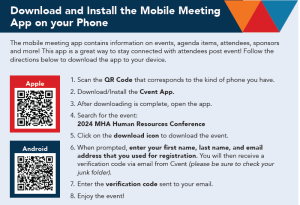

Written by Mary Rosser, MA, SHRM-CP, Chief Human Resources Officer, Trinity Health Grand Rapids Hospital
The 2024 MHA Human Resources Conference gathered almost 100 healthcare human resource leaders to explore innovative recruitment and succession planning strategies and network with peers from across the state in-person for the first time in four years.
Following panel discussions and learning labs, attendees walked away with innovative, actionable solutions for overcoming human resources challenges within their organization.
Groups shared their ideas at the end of the learning labs, and individuals shared their top takeaways at the end of the event. Below are some of the top takeaways from the event.
- Create partnerships with educational institutions (K-12, college-level and beyond) and state agencies to collaborate on solutions to address workforce shortages.
- Leverage government programs and resources available to get in front of future healthcare talent. Lean on organizations like Michigan Economic Development Corporation and Michigan Works! to explore partnership opportunities. The MI Hospitals Careers website also provides resources and information on healthcare careers.
- Meet the candidates where they are. Stop expecting candidates to come to your organization or even website. It is important to be where they are and put content where they are.
- Understand what sets you apart and promote it! Know what makes you special as an employer. Is it your culture? Is it your benefits or training program? Market your unique value to potential candidates.
- Think outside of the box when it comes to recruitment. Highlight the organization in ways that haven’t been done before. Also, be mindful that it doesn’t end with recruitment – provide opportunities for new hires to build their career and meaningful relationships.
- Connect with individual team members about their goals and career aspirations. To get ahead on succession planning, make it a regular practice to ask employees about their skillset, personal career goals and any aspirations including their desire (or not) to become a leader within the organization.
- Be intentional about communicating with leadership about potential future leaders. As a follow-up to takeaway #6, don’t wait until there is a management role to fill to connect with leadership on the goals and aspirations of team members.
- Use tools that makes this process manageable. Leverage technology that creates trackable and frequent conversations between supervisors and employees about career desires, strengths, and opportunities.
- Build a culture of trust from the top-down. Ensure your healthcare teams feel supported by leaders at every level and comfortable to collaborate with their colleagues, department heads and executives.
- Reflect on your role within an organization as an HR leader. Consider how others in the organization may be viewing you and address any misalignment between your perception and others’ perceptions.
At the event, Kerry Ebersole Singh, chief talent & engagement officer, Michigan Economic Development Corporation, presented on what Michigan leaders are doing to attract and retain talent for the state.
Those interested in connecting with attendees from the event can utilize the event app for up to 90 days after the event to connect with attendees and panelists, including the following individuals:
- Jeremy Cannon, VP and chief nursing officer, Kalkaska Memorial Health Center
- Jason D. Graves, system manager of recruitment and workforce development, MyMichigan Health
- Meleah Mariani, chief nursing officer, Corewell Health Ludington Hospital
- Erin Kujawski, regional director – organizational effectiveness, U-M Health Regional Network, UM Health – West, Sparrow Health System
- Jeremiah Hodshire, president & chief executive officer, Hillsdale Hospital
- Joel W. McDermott, VP, talent & culture, Corewell Health

